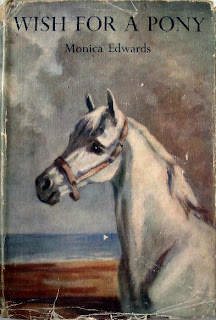Guest blogger - Linda Newbery on Monica Edwards
I can say without doubt that Monica Edwards made me want to be a writer from an early age.
Wish for a Pony was my first encounter, at the age of eight. There’s something special about the books we love as children, something I don’t think we can experience as adults. I read and re-read Wish for a Pony so many times that I could recite chunks now, smell the paper, and see the Anne Bullen illustrations. I virtually inhabited Westling; wanted Tamzin and Rissa for my friends and Jim Decks to confide in. At that age I was taken with the wish-fulfilment of the plot, but what has lingered most is the warmth and solidity of the characters and the setting.
No Mistaking Corker came next; then Armada paperbacks appeared, and I was delighted to discover how many books there were; I felt they’d been written just for me. I was addicted, buying Armadas, requesting hardbacks from the library, growing up with Tamzin and Lindsey. Punchbowl Midnight and The Spirit of Punchbowl Farm were my favourites, together with Hidden in a Dream. I pored over the maps; identified strongly with Lindsey (more than with Tamzin; I wasn’t brave or beautiful enough, and would certainly never have attracted a Meryon); agonized with her over the fate of the yew tree, the dehorning of cattle, the shooting of deer. Monica Edwards was a pioneer environmentalist, writing about such things as the capture of dolphins, the destruction of habitats and the oiling of seabirds long before these were the familiar topics they are now. Elaine, the main character in my first published book, Run with the Hare, who becomes involved in an animal rights group, surely owes something to Lindsey. (And I couldn’t resist using the name Tamsin – with this more common spelling – for the heroine of A Fear of Heights.)
From the age of ten I was trying to write novels, hiding them in my wardrobe. Of course, I wanted to be Monica Edwards; later, other writers exerted their influence. But what has always stayed with me is her evocation of place. I knew Romney Marsh and Punchbowl Farm in all seasons and all weathers; I saw them with Monica Edwards’ painterly eye. This sense of place is important to my own books. I don’t write series fiction, but several of my novels (The Shell House, Set in Stone, The Sandfather, Nevermore – well, nearly all of them) have started with a particular place and atmosphere. Like Monica Edwards, I want to take my readers there, make the places real in their imaginations. Most are set in the countryside, several featuring a central character who has moved there from town or city.
I met Monica Edwards through an act of what now seems colossal cheek. Returning from a Sussex
I’m sorry that I didn’t send her one of my books before it was too late, thanking her for my enormous enjoyment of her work, and for making me a writer. I know now how much it would mean to me if I could be someone else’s Monica Edwards. Maybe …



Comments
I'm massively jealous that you met Monica - but really delighted that she was as nice as you'd hoped. I hate it when dreams are shattered!